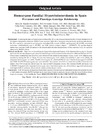Identificador persistente para citar o vincular este elemento:
https://accedacris.ulpgc.es/jspui/handle/10553/47116
| Título: | Homozygous familial hypercholesterolemia in Spain prevalence and phenotype-genotype relationship | Autores/as: | Civeira Murillo, Fernando Stef, Marianne A. Pérez Calahorra, Sofía Almagro Múgica, Fátima Plana Gil, Nuria Sáenz Aranzubía, Pedro Enrique Mosquera Lozano, Daniel Soler i Ferrer, Cristina Fuentes Jiménez, Francisco José Brito Casillas, Yeray Real Collado, José Tomás Blanco Vaca, Francisco Ascaso Gimilio, Juan Francisco Pocovi Mieras, Miguel Sánchez Hernández, Rosa María Novoa Mogollón, Francisco |
Clasificación UNESCO: | 32 Ciencias médicas 3207 Patología 320704 Patología cardiovascular |
Palabras clave: | Alleles Hypercholesterolemia Lipids Mutation Registries |
Fecha de publicación: | 2016 | Editor/a: | 1942-325X | Publicación seriada: | Circulation. Cardiovascular genetics | Resumen: | Background-Homozygous familial hypercholesterolemia (HoFH) is a rare disease characterized by elevated plasma levels of low-density lipoprotein cholesterol (LDL-C) and extremely high risk of premature atherosclerotic cardiovascular disease. HoFH is caused by mutations in several genes, including LDL receptor (LDLR), apolipoprotein B (APOB), proprotein convertase subtilisin/kexin type 9 (PCSK9), and LDL protein receptor adaptor 1 (LDLRAP1). No epidemiological studies have assessed HoFH prevalence or the clinical and molecular characteristics of this condition. Here, we aimed to characterize HoFH in Spain. Methods and Results-Data were collected from the Spanish Dyslipidemia Registry of the Spanish Atherosclerosis Society and from all molecular diagnoses performed for familial hypercholesterolemia in Spain between 1996 and 2015 (n=16 751). Clinical data included baseline lipid levels and atherosclerotic cardiovascular disease events. A total of 97 subjects were identified as having HoFH-of whom, 47 were true homozygous (1 for APOB, 5 for LDLRAP1, and 41 for LDLR), 45 compound heterozygous for LDLR, 3 double heterozygous for LDLR and PSCK9, and 2 double heterozygous for LDLR and APOB. No PSCK9 homozygous cases were identified. Two variants in LDLR were identified in 4.8% of the molecular studies. Over 50% of patients did not meet the classical HoFH diagnosis criteria. The estimated HoFH prevalence was 1: 450 000. Compared with compound heterozygous cases, true homozygous cases showed more aggressive phenotypes with higher LDL-C and more atherosclerotic cardiovascular disease events. Conclusions-HoFH frequency in Spain was higher than expected. Clinical criteria would underestimate the actual prevalence of individuals with genetic HoFH, highlighting the importance of genetic analysis to improve familial hypercholesterolemia diagnosis accuracy. | URI: | https://accedacris.ulpgc.es/handle/10553/40325 | ISSN: | 1942-325X | DOI: | 10.1161/CIRCGENETICS.116.001545 | Fuente: | Circulation. Cardiovascular Genetics [ISSN 1942-325X], v. 9 (6), p. 504-510 |
| Colección: | Artículos |
Citas SCOPUSTM
58
actualizado el 08-jun-2025
Citas de WEB OF SCIENCETM
Citations
52
actualizado el 08-jun-2025
Visitas
56
actualizado el 10-feb-2024
Descargas
45
actualizado el 10-feb-2024
Google ScholarTM
Verifica
Altmetric
Comparte
Exporta metadatos
Los elementos en ULPGC accedaCRIS están protegidos por derechos de autor con todos los derechos reservados, a menos que se indique lo contrario.
